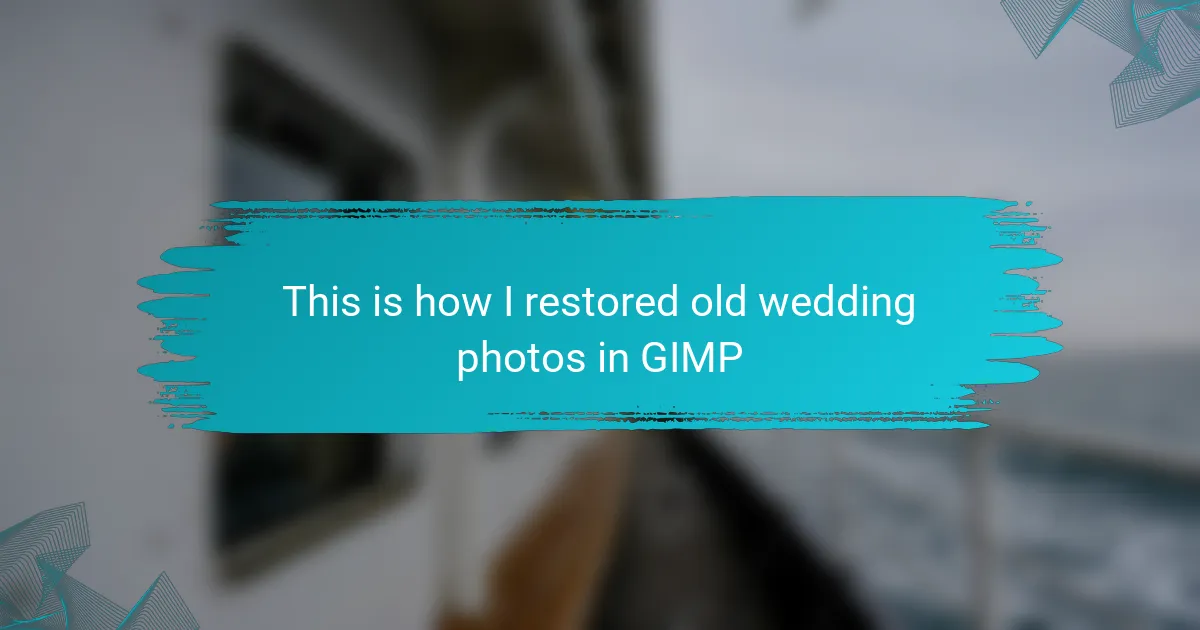Key takeaways
- Wedding photography serves as a narrative tool, capturing unforgettable emotions and moments that create lasting memories.
- Photo restoration is crucial for preserving cherished images, allowing future generations to connect with their family history and stories.
- GIMP is a versatile software that aids in photo restoration with tools for healing, color correction, and layer adjustments.
- Enhancing photo quality through brightness, contrast, and sharpening can revive old images, making them feel fresh and vivid again.
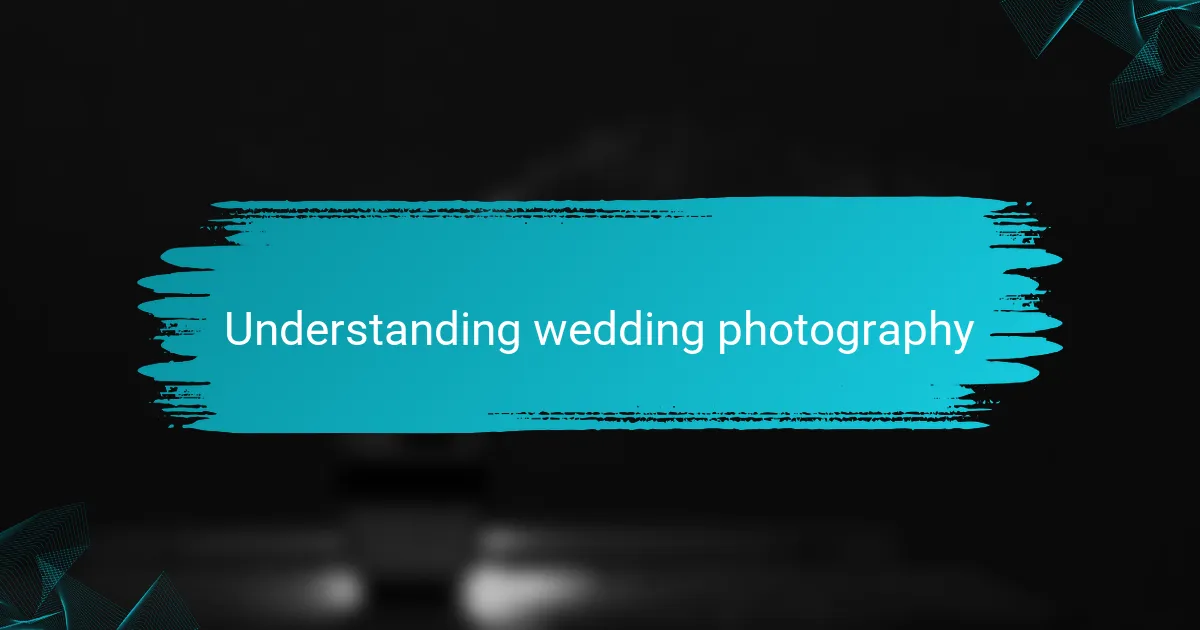
Understanding wedding photography
Wedding photography is not just about capturing images; it’s about telling a story. Each photograph has the power to transport us back to moments filled with love, joy, and sometimes even happy tears. I often find myself looking at old wedding photos and recalling the emotions of that day, which reminds me why preserving those memories is so important.
The choice of style—whether traditional, photojournalistic, or artistic—dictates how these stories unfold. Have you ever considered how a single photograph can convey the essence of a couple’s love or the atmosphere of their celebration? I’ve always appreciated the details: the way light falls on a couple’s hands, the expressions of friends and family, and those candid moments that truly capture the spirit of the day.
Additionally, the techniques employed in wedding photography can greatly enhance the narrative. From soft focus to vivid color correction, each choice influences how we remember those special moments. I relish the creativity in selecting backdrops that add to the image and evoke emotion, turning a simple photograph into a cherished memory.
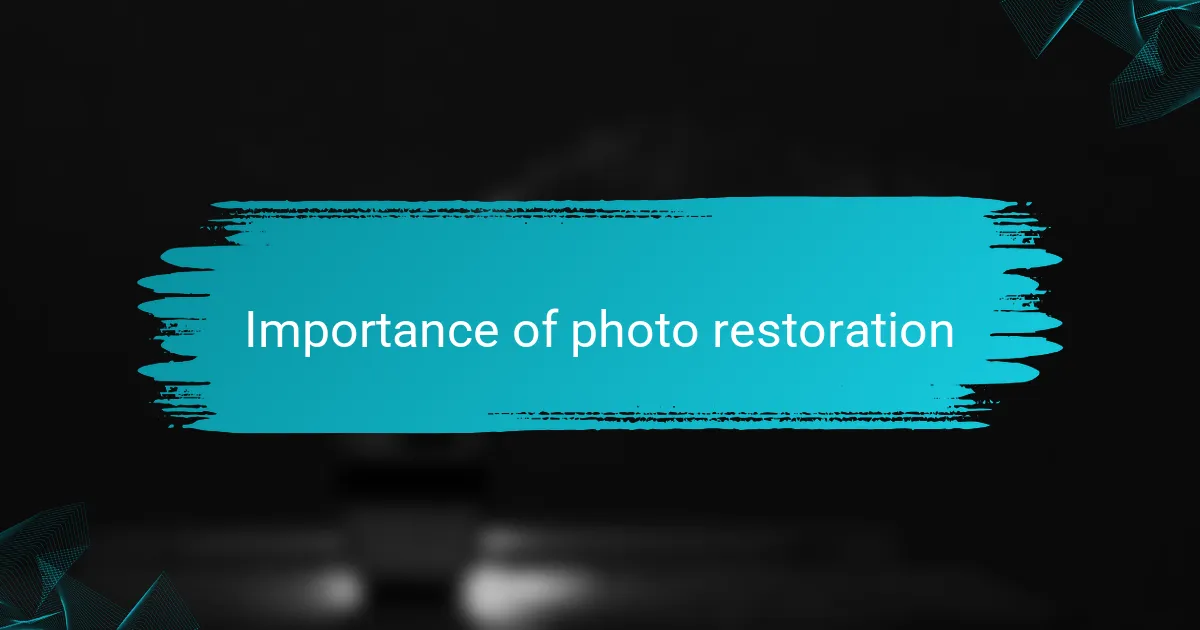
Importance of photo restoration
The importance of photo restoration cannot be overstated, especially for cherished memories like wedding photos. These images capture pivotal moments of love and joy but can fade or deteriorate over time. I’ve personally experienced the joy of seeing my grandparents’ wedding photos come back to life, which brought back a flood of emotions and reminded me of the love story that started it all.
Preserving these memories allows future generations to connect with their family history. I’ve often found that restored photos act as conversation starters, igniting stories that might otherwise have been lost. The act of restoring these pictures is not only a way to beautify them but also to honor the moments and people they represent.
| Original Condition | Restored Condition |
|---|---|
| Faded colors | Vibrant tones |
| Scratches and tears | Smooth and intact |
| Blurred images | Sharp details |

Overview of GIMP software
GIMP, which stands for GNU Image Manipulation Program, is a powerful open-source software for photo editing and graphic design. I’ve often found it to be an invaluable tool for restoring old photos, especially those sentimental wedding images that carry so much meaning. The flexibility it offers allows for detailed edits, from color correction to removing blemishes that time has left behind.
One of the features I appreciate most about GIMP is its extensive range of plugins and filters. These can enhance restoration processes significantly, enabling me to achieve results that closely mirror the original quality of faded photographs. Have you ever struggled to get a specific shade just right? GIMP’s color balance and adjustment tools mean I can take my time to perfect even the most nuanced tones, evoking the memory of that special day more vividly.
With a bit of a learning curve, GIMP can feel overwhelming at first, but I found the effort worthwhile. I remember the first time I restored a beloved wedding photo using it; the thrill of seeing those smiles back to life was truly rewarding. It’s a reminder that, with the right tools and some perseverance, we can capture and preserve the emotions and memories that matter most—long after the original moment has passed.
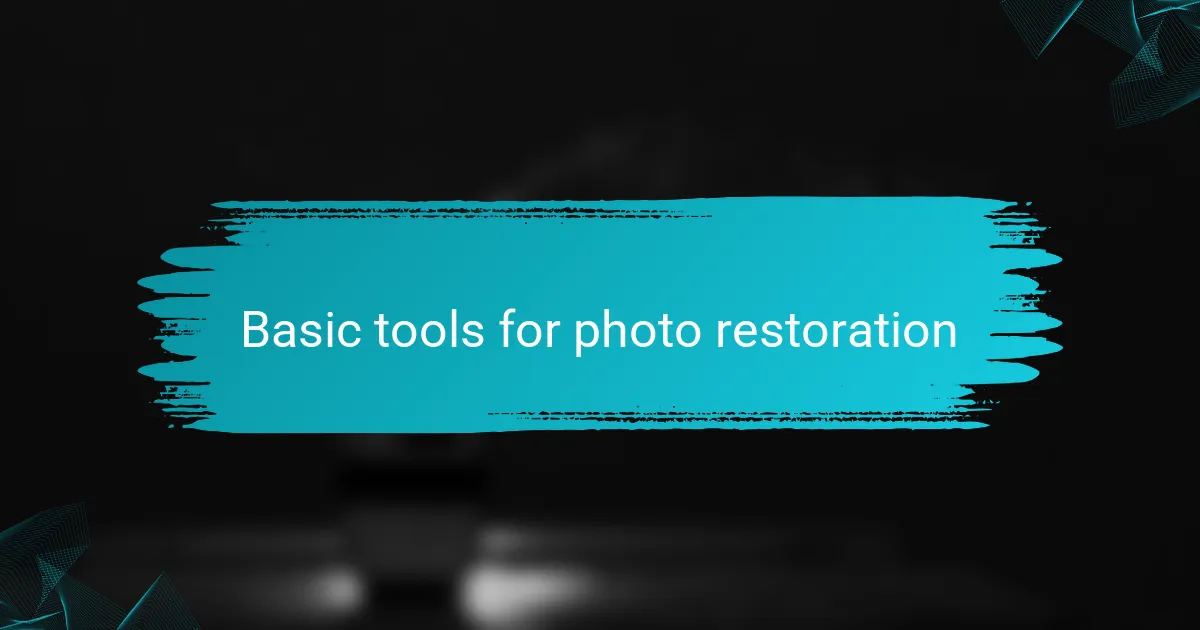
Basic tools for photo restoration
Using GIMP for photo restoration opens up a whole new world of creative possibilities. One of my go-to tools is the Healing Tool, which works wonders on scratches and imperfections. I remember restoring a black-and-white wedding photo from the 1970s; each swipe felt like I was polishing a gem, revealing the image as it was meant to be seen. Can you imagine the satisfaction of helping a cherished moment shine again?
Color correction tools in GIMP are indispensable, especially when dealing with faded hues. I often find myself adjusting the color balance to breathe life back into the images. It’s fascinating to see how vibrant the gowns, flowers, and decor can return, bringing back the essence of that special day. Do you remember the colors from your wedding? It’s amazing how these adjustments can evoke those memories so vividly.
For precision adjustments, layers are my best friend in GIMP. Using layers allows me to overlay edits without permanently altering the original photo. I distinctly recall layering adjustments while restoring my parents’ wedding photograph. Each layer represented a step closer to bringing their story back into focus. The entire process reminded me of piecing together a beautiful puzzle, one that holds so much love and history.
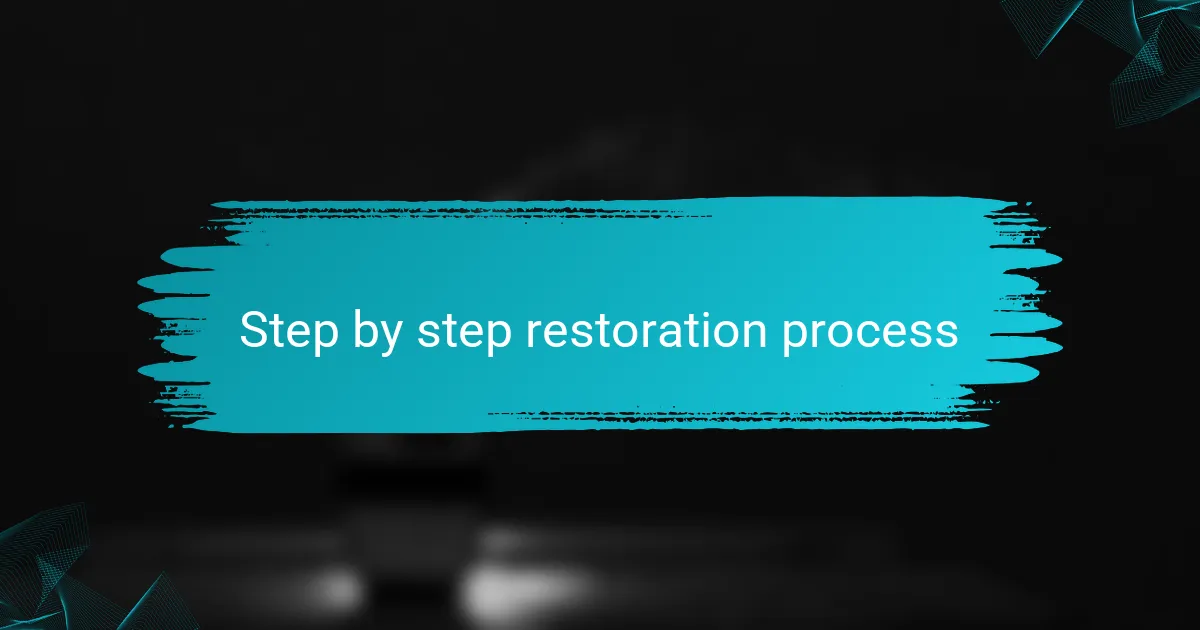
Step by step restoration process
Restoring old wedding photos in GIMP can be an exciting journey, and I like to start by preparing the image. First, I scan the photograph at a high resolution to capture all the details. It’s a bit like unwrapping a precious gift. Once I’ve got the digital version, I open it in GIMP and make a backup layer. This gives me the freedom to experiment without fear. Have you ever felt the thrill of unraveling a faded memory?
Next comes the Healing Tool, which I approach as a craftsman would. I remember restoring a treasured image of my grandparents on their wedding day, and each correction felt like I was breathing life back into their smiles. The tiny scratches and faded spots vanished under my fingertips, revealing the joy that once filled that day. The transformation is often magical. Isn’t it incredible to witness a memory re-emerge so vividly?
After the initial fixes, I dive into color correction, utilizing the color balance adjustment. I’ve often found that this step can turn a drab image into a mesmerizing piece of art. During one restoration, tweaking the hues brought back the delicate pastel of the flowers my aunt carried. It reminded me of the laughter shared around her bouquet. Every adjustment not only restores the photo but also ignites the emotions tied to those moments. Isn’t it fascinating how color can evoke memories?
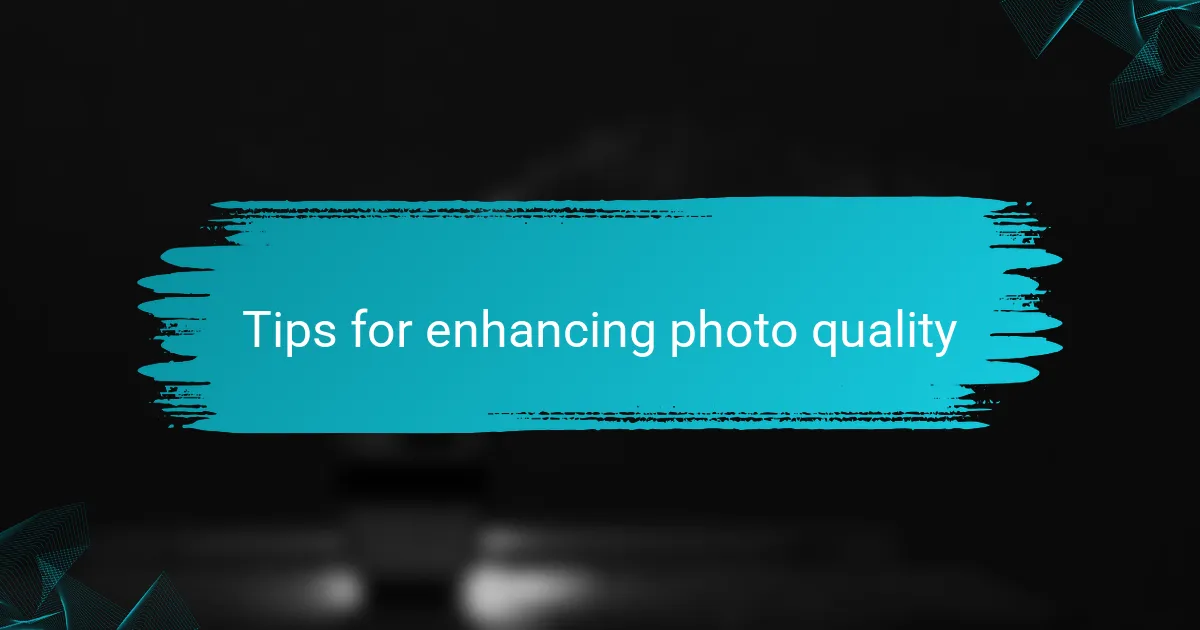
Tips for enhancing photo quality
When it comes to enhancing photo quality, I’ve found that adjusting brightness and contrast can work wonders. Often, old wedding photos tend to be a bit dull, so I play with these settings to bring back some life. A little experimentation here can reveal details that you might have thought were lost forever.
Another tip I swear by is sharpening the image. I remember restoring my grandparents’ wedding photo, and with just a bit of sharpening, their smiles became so much more vibrant. It’s like rediscovering buried treasure every time I see the transformation.
Finally, don’t underestimate the power of color correction. Sometimes those old prints take on unexpected hues over time. Fixing these can breathe new life into the memories captured in those images, making them feel fresh yet nostalgic.
| Technique | Description |
|---|---|
| Brightness and Contrast | Adjust to reveal details in faded images. |
| Sharpening | Enhances clarity and vibrancy of the subject. |
| Color Correction | Restores true colors, bringing life back to old photographs. |
